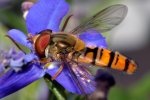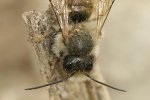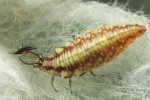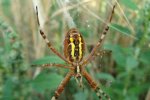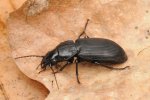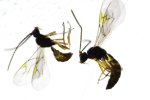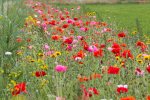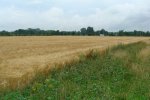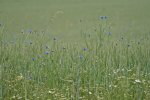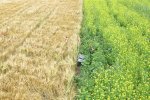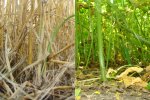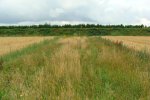Edition
Bugs for buzziness - capturing the services of beneficial insects
Beneficial arthropods such as pollinators (e.g. bees and hoverflies), predators (e.g. ladybeetles and spiders) and parasitoids (e.g. parasitoid wasps) play a key role in agricultural production because they provide pollination and suppress pest populations. These so called arthropod-mediated ecosystem services are estimated to have a value of more than 500 billion US $ worldwide per year. While the concept of nature helping mankind may seem simple, there are many socio-economical, technical and ecological challenges involved in the management of these ecosystem services. Recent research in our group on the arthropods that provide ecosystem services offers new possibilities for the design of agricultural landscapes that are less dependent on pesticides.
(by Jan ten Hoopen)
Arthropods that pollinate crops or suppress pest populations depend on several resources and habitats. Many of these beneficial arthropods cannot survive in agricultural landscapes without semi-natural habitats such as hedges, forests, or ponds. In these natural habitats they hibernate or hide from predators, forage for pollen and nectar, or search for alternative hosts and prey when these are no longer available in the agricultural fields. For instance, flowering wild plants provide nectar and pollen, resources that are needed to complete the life cycle of many pollinators and natural enemies. These semi-natural habitats and associated wild plants are under pressure together with the beneficial arthropod communities that they support. This can be partly contributed to decades of large-scale herbicide and pesticide use, which reduced the availability of wild flowers and beneficial arthropods in agricultural landscapes. Biodiversity-friendly management, such as the creation of (semi-)permanent habitats or pesticide-free zones along arable fields, may contribute to the restoration of 'functional biodiversity' and the associated ecosystem services. As organically managed fields are free from synthetic pesticides and herbicides, these fields can to some extent also offer suitable habitats for beneficial arthropods. However, it is still unclear how organic management and the type and quantity of natural habitat influence the abundance, spread and efficiency of beneficial arthropods in the landscape. Felix Bianchi, researcher at our group, and Bas Allema who recently graduated as a PhD, address these issues in their research.
Figures 1-6 Beneficial arthropods are a diverse group of mainly insects, spiders, and predatory mites. Some play an important role in pest suppression or pollination as adult, others as larva and some both as larva and adult. Click the pictures for larger pictures and more information.
In recent years, the creation of (semi-)permanent vegetation strips around arable fields has become a popular measure to enhance the diversity and abundance of beneficial arthropods in crops. While arthropods clearly benefit from these vegetation strips, their contribution to biological pest control is not always evident. The vegetation composition, area and spatial arrangement of these strips in the landscape all play a role in the way how these habitats support ecosystem services. Furthermore, semi-natural habitats may be a source of beneficial arthropods and facilitate their dispersal into adjacent crops, but they may also limit the movement of species between fields. Bas Allema, who recently graduated as a PhD at Farming Systems Ecology, investigated in collaboration with the Laboratory of Entomology and the Centre of Crop Systems analysis the movement of the ground beetle Pterostichus melanarius in relation to vegetation type, and spatial arrangement of the different habitats.
Figures 7-9 Outside natural areas, flowering plants can be found in temporary or semi-permanent field margins, but also in the fields. Click the pictures for larger pictures and more information.
Together with spiders, ground beetles are the main predators in crop fields. Here, they consume large quantities of other insects, slugs and weed seeds. By doing so they can contribute to reducing pest pressure of some important pest species. Pterostichus melanarius thrives in open and disturbed habitats and is one of the most common ground beetles on arable land. The mostly nocturnal lifestyle of the grown beetle, and the underground lifestyle as larva, make it relatively well adapted to life in agricultural fields. Still, population levels will be negatively influenced by disturbances such as pesticide applications and tillage. A fast field colonization from less disturbed habitats is therefore important to replenish the field populations, before pest populations cause serious economic damage. The spatial distribution of habitats and the movement behavior of the beetle play an important role in the potential of P. melanarius to provide biological control services.
In search for suitable prey and habitats, P. melanarius may encounter several obstacles on its way through the landscape, such as roads and ditches, but also dense vegetation in field margins. Because a beetle has no sense of what habitat is present on the other side of a crop boundary, its behavior at the boundary determines whether it will move to another field or not. Bas' research focused on the movement behavior of the beetle at these habitat boundaries. He compared, for example, the movement of beetles in fields of oilseed-radish (Raphanus sativus), rye (Secale cereale) and grass margins surrounding these crops. He also measured the number and direction of beetles moving between these different habitats. The results of the field experiment were compared with a computer model and with video observations on the beetle’s movement behavior in a greenhouse.
Figures 10-12 Interfaces between crops and between crops and field-margins. Click the pictures for larger pictures and more information.
Bas’ experiments showed that P. melanarius movement behaviour was not different between the oilseed radish and rye crop, but that at the interface between the crops beetles preferred to move to the oilseed radish. The greater preference for oilseed radish may be explained by better vegetation cover against bird predators, and higher humidity than in a cereal crop. At the border between the crops and the grass margins, beetles showed a strong preference for crops. Movement in these grass margins was also four to eight times slower, compared to movement in the crops. These results indicate that the spatial arrangement of crops and semi-natural habitats may influence the spatial distribution of this important predator in the landscape.
While ground beetles such as P. melanarius can cope relatively well with in-field disturbances, other natural enemies, such as parasitoid wasps, depend heavily on less disturbed habitats for their survival. As parasitoid wasps can be found in the upper part of the crop canopy, they may be more vulnerable to insecticides than ground dwelling arthropods. The small size of these insects also adds to their vulnerability, as the sensitivity to insecticides is correlated with body weight. Re-colonization of the fields after an insecticide application often happens from surrounding semi-natural habitats. Another important factor for parasitoid wasp survival is the presence of floral resources. These resources are often scarce in modern agricultural landscapes. The adult wasps can survive without food for a few days, but will live considerably longer with access to nectar from flowering plants. Unless the crops offer accessible nectar, their effectiveness in supporting biocontrol will depend strongly on wild flowers in and around the fields.
Organic fields typically support a higher abundance and diversity of natural enemies than conventional fields because they often contain more flowering plants and no synthetic insecticides are used. As organic farming is increasing worldwide, the potential of biocontrol by natural enemies may therefore increase. This may offer opportunities for organic farms, but also for conventional farms that increasingly work with the concept of Integrated Pest Management (IPM). Biocontrol by natural enemies is the first-line defense against pest species in this IPM approach and insecticides are only used when pest species get out of control. The ‘spill-over’ of parasitoid wasps and other natural enemies from organic fields to adjacent conventional fields might then result in a better pest control in conventional fields as well. However, it is also possible that organic fields are a source of pests, and in this case conventional farms may suffer from the spill-over of pests. An alternative scenario is that insecticide use in conventional fields will kill the ‘spill-over’ of natural enemies from adjacent organic fields to such an extent that it has a negative effect on pest control by natural enemies in these organic fields. The conventionally managed fields then act as an trap: natural enemies are attracted to the pest species in these fields but are killed by broad-spectrum insecticides.
All these scenarios are likely influenced by the total area of organic versus conventional fields, the spatial pattern of these fields in the landscape (e.g. clustered or randomly distributed), and the type of insecticides used (e.g. broad-spectrum vs selective). In one of his research projects, Felix Bianchi explored the effects of some of these factors on parasitism and pest pressure in a landscape composed of organic and conventional fields using a simulation model. He found some interesting results indicating that mixing insecticide-based and natural-enemy based pest-management on a landscape level can give a wide range of outcomes. In the worst case scenario, insecticide use can result in lose-lose scenarios with increased pest loads for both organic and conventional fields. In contrast, when using selective insecticides and clustering organic fields reducing the disruptive effects of insecticide use, insecticide use appeared to be compatible with biocontrol in some scenarios. Other interesting outcomes were that parasitoids need an minimum area of organic fields for effective pest control. When the total area of organic fields gets below this threshold, the landscape can no longer sustain parasitoid populations. It was shown that individual traits of the parasitoids influence the size of this area. Parasitoids with high attack rates have the ability to respond fast on growing host populations, and could therefore survive with smaller areas of organic fields.
- Unfortunately, your cookie settings do not allow videos to be displayed. - check your settings
We cannot tell insects what to do, but we can try to design landscapes that support natural enemy populations by offering resources and suitable habitats, and facilitate the colonization of fields. This is a complex puzzle as landscapes harbor an overwhelming number of species that all interact with each other. For example, the beetle that Bas studied not only feeds on pests, but also doesn’t mind eating other natural enemies! And, as Felix’ study shows, the efficiency of biocontrol depends strongly on how fast a natural enemy can respond to growing pest populations. Also, in the simulation studies the landscape was build-up of very basic elements such as agricultural fields and grassy vegetation strips. In the real world agricultural landscapes are far more complex with different types of semi-natural habitat, crops that change in time, and other elements like roads and water that can influence species distributions and biocontrol efficiency. As such, the models described here are of course simplifications of real situations. However, the results from the field experiments of Bas and the simulation models of Felix give valuable insights in the processes and trade-offs of our management decisions in farming and landscape design. These are important steps towards improving arthropod-mediated ecosystem services.
